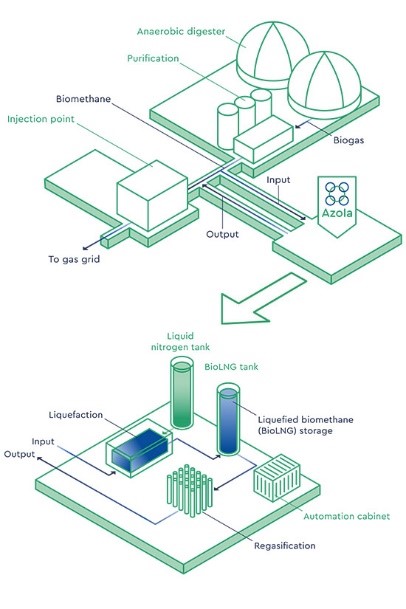
Azola SAS: Increasing Efficiency and Flexibility of Anaerobic Digestion Plants and Gas Networks

Azola, a start-up company based out of France, has developed tailor-made solutions and services that enable customers to expand their biomethane injection capabilities and maximize income from methanization units.
Biomethane Storage Solution
Azola's intermittent biomethane storage solution, Azola BIO, can be used by natural gas producers to store, in liquid form, surplus biomethane from injection plants during periods of low demand.

Diagram showing the components that make up an Azola unit.
At times, congestion can occur in the natural gas distribution network, such as on weekends and, during the summer when a producer reaches their maximum contractual injection rate, or during maintenance work. When congestion happens, biomethane is sometimes flared to decrease the pressure levels within the distribution grid or to avoid penalties due to excess biomethane production. Azola BIO technology allows small- to medium-sized natural gas producers (i.e., those who produce up to 500 normal cubic meters per hour) to temporarily store the biomethane, which is then reinjected when permitted by the distribution pipe pressure levels.
GRID Solution
Azola’s GRID solution provides flexibility to the natural gas distribution network by automatically storing grid gas under liquid form as soon as a preset maximum operating pressure is reached. Once the congestion dissipates, the unit starts re-injecting the stored gas on the same part of the grid or transporting the stored liquefied natural gas (LNG) to another part of the grid. Azola GRID is made of transportable skids that can be easily disconnected and removed from one part of the network to another, depending on operational needs. An industrial demonstrator is currently under procurement phase and is due for commissioning in 2021. This project is the result of a partnership between Azola and Gaz Réseau Distribution France (GRDF), the national distribution network operator in France, and is supported by the Région Auvergne Rhône Alpes (AURA).
Achieving Results
Flaring because of congestion constraints generally takes place over 20 weekends a year, spanning approximately 5-15% of a plant’s annual production.
Biomethane injection sites can vary their injection flow rates by only a small percentage during the day due to the limited storage capacity of digesters. Biomethane producers are, therefore, forced to flare their production when they cannot inject biomethane into the network. These difficulties affect one out of five projects in certain regions in France; with this injection flow rate set to increase, each new project will further reduce the demand volumes available for the following project.
Azola BIO has been proven to enhance the profitability of methanization plants subject to summer injection constraints, allowing them to:
- Store lost biomethane volumes during summer periods, yielding gains of around 10% of the annual production capacity
- Manage the monthly injection quotas, achieving gains in the range of 2 to 5% of the annual production
For a typical agricultural-scale methanization unit in France with a 250 Nm3/h biomethane injection capacity:
- Production losses avoided would be 260,000 Nm3/year (12%), or approximately 260 k€ per year
- Annual operating costs of Azola BIO would be estimated at 70 k€/year (20 k€ fixed share and 50 k€ variable one)
- Azola BIO would increase operating revenue by 190 k€ per year (2.85 m€ over 15 years)
- Payback time would be under 4 years (3 years and 5 months)
When network congestion occurs, storage capacities of injection plants and gas networks do not allow differences between production and instantaneous consumption curves. As a result, flaring often takes place, resulting in a loss of revenue and a waste of biomethane.
Biomethane production facilities are highly capital intensive and require high operating and recovery rates to ensure their profitability. Therefore, injection constraints represent losses of revenue and turnover discrepancies that discourage banks from engaging with such projects. This leads to profitability hurdles and even project insolvencies, thus slowing down the overall development of the sector.
Azola’s solutions can be used to recover this lost value, resulting in a more overall profitable and resilient sector, which would further boost the development of new projects and lower onsite greenhouse gas emissions.
Furthermore, in agricultural, small-scale AD plants, Azola BIO could avoid methane release into the atmosphere of about 172 tonnes of CO2eq per year due to flaring . Assumption made for 410 h/y of down time basis (low scenario of 5% of 8200 h), biomethane produced at 250 Nm3/h undergoes a complete 1:1 combustion. For a Volume of biomethane treated of 102,5 kNm3:
- CO2 emitted: 28 t CO2eq/year
- Liquid N2 consumed and vented: 155 kNm3
- Energy used: 0.98 kWh/Nm3
Ongoing Projects
Azola BIO Unit:
- Project Epaux Bézu: A demonstrator (scale 1:1) has been successfully tested in real life conditions on an AD plant in Epaux-Bézu (North of Paris) from 2017 to 2019 following successful lab testing. The experimental program developed and successfully tested on site enabled Azola to upgrade the technology readiness level (TRL) of the Azola BIO solution from TRL 4-5 to TRL 8.
- Project Plainval: Currently under advanced procurement phase, the plant is set to start operating soon with a liquefaction capacity of 250 Nm3/h of biomethane, and a storage capacity of 20 Nm3 of bioLNG.
Azola GRID Unit:
- Project Flores: Azola GRID solution will be tested for average flow rates of 250 Nm3/h, and pressures of 4, 8, and 16 barg starting in 2021 via the installation of a 1:1 scale demonstrator built in partnership with GRDF. This project aims at bringing Azola GRID to TRL 8.
Innovation Serving the Biomethane Sector
Azola solutions were developed to provide increased flexibility to biomethane producers (Azola BIO) as well as to grid infrastructures (Azola GRID)by temporarily storing biomethane under liquid form. They were also developed to shift the timing of injections to periods when grid consumption outweighs instantaneous biomethane production. The technology behind the Azola process (under research since 2014) is based on a liquid nitrogen open cycle and where nitrogen is further valorized to regenerate the polishing unit's adsorption columns. This is combined with a proprietary CO2 purification process. Azola developed a modular, no rotary machinery and low capital expenditure (CAPEX) solution for biomethane producers that comes with an integrated polishing, liquefaction-cryogenic storage, vaporization-reinjection, and plant control solution. The reinjection module uses a pressure build up (PBU) system to vaporize and reinject the stored liquid biomethane into the grid. The entire process is automated for start-up and shutdown and could be remotely controlled and operated.
Information about Azola's services.